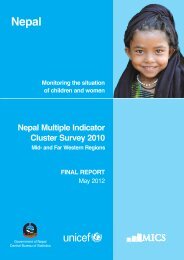Small Area Estimation of Poverty
Small Area Estimation of Poverty
Small Area Estimation of Poverty
- No tags were found...
You also want an ePaper? Increase the reach of your titles
YUMPU automatically turns print PDFs into web optimized ePapers that Google loves.
4. Results4.1 Strata-level results in comparison with NLSS3To get a general idea <strong>of</strong> the larger welfare trends, as wellas to judge the accuracy <strong>of</strong> our prediction models, we firstcompare the small-area estimations against the povertyincidence directly observed from NLSS3 at the strata level.This is the lowest level at which the household survey isrepresentative. Strata-level poverty rates are presentedin Table 2. The Z-value can be used to assess whetherthe predicted measure <strong>of</strong> poverty incidence FGT(0) iswithin two standard errors from the observed FGT(0) inthe NLSS3 11 . These Z-scores indicate that the small-areaestimations <strong>of</strong> poverty incidence based on our regionalmodels are generally within two standard errors <strong>of</strong> thepoverty incidence rates in the survey. However, two out<strong>of</strong> the 15 results fall outside the confidence interval <strong>of</strong> twostandard errors. <strong>Poverty</strong> incidence in rural central hilland rural western hill are predicted to be respectively17.4% and 20.2% compared to direct estimates from thesurvey <strong>of</strong> respectively 29.4% and 28%. Another thing tobe noted from the table is that the three regional modelsseem to do similarly well in predicting poverty. <strong>Poverty</strong>for Nepal as a whole lies well within the 2 standard errorbounds. It also reflects the trend <strong>of</strong> a poverty rate thatis decreasing over time: the country’s headcount ratecontinues its steady decline from 60 % in 1995/96, to49 % in 2003/04, to 25% in 2010/11, using comparableconcepts <strong>of</strong> consumption (monthly recall) and povertylines.The small area estimations <strong>of</strong> poverty, though generallywithin the confidence interval, are for the majority <strong>of</strong>strata somewhat lower than the direct estimates from thehousehold survey. This could be related to an issue notedearlier - census means <strong>of</strong> common variables being mostly‘better <strong>of</strong>f’ than population-weighted survey means.Table 2: Predicted poverty rates on the target level - by stratum and in comparison to NLSS3 poverty ratesObserved poverty rates NLSS IIIPredicted poverty rates at the target level# households FGT(0) # households FGT(0) FGT(1) FGT(2)Z-ValueMountain Mean 408 0.423 363,698 0.398 0.104 0.039 -0.552S.E. mean 0.043 0.014 0.005 0.002Urban-Kathmandu Mean 864 0.115 273,733 0.110 0.022 0.007 -0.307S.E. mean 0.015 0.005 0.002 0.001Urban-Hill Mean 480 0.087 335,015 0.104 0.023 0.008 0.613S.E. mean 0.021 0.019 0.005 0.002Rural-Hill-Eastern Mean 384 0.159 318,511 0.186 0.037 0.011 0.860S.E. mean 0.030 0.008 0.002 0.001Rural-Hill-Central Mean 480 0.294 598,323 0.174 0.040 0.013 -2.279S.E. mean 0.052 0.009 0.003 0.001Rural-Hill-Western Mean 480 0.280 542,632 0.202 0.047 0.016 -2.125S.E. mean 0.036 0.006 0.002 0.001Rural-Hill-Midwestern Mean 336 0.316 315,318 0.315 0.074 0.025 -0.034S.E. mean 0.044 0.007 0.002 0.001Rural-Hill-Farwestern Mean 180 0.476 147,832 0.472 0.128 0.048 -0.052S.E. mean 0.063 0.008 0.003 0.001Urban-Terai Mean 672 0.220 424,461 0.162 0.039 0.014 -1.442S.E. mean 0.035 0.020 0.006 0.002Rural-Terai-Eastern Mean 480 0.210 647,025 0.225 0.050 0.016 0.461S.E. mean 0.032 0.009 0.003 0.001Rural-Terai-Central Mean 480 0.231 713,183 0.242 0.055 0.018 0.390S.E. mean 0.027 0.006 0.002 0.001Rural-Terai-Western Mean 348 0.223 331,598 0.236 0.056 0.020 0.256S.E. mean 0.051 0.012 0.003 0.00111. It is defined as: Z = ( FGT(0) census - FGT(0) survey ) / √[ (S.E. census)2 + (S.E. census)2]. The value <strong>of</strong> Z should thus not exceed │2│for both measures to represent the samepoverty incidence.NEPAL <strong>Small</strong> <strong>Area</strong> <strong>Estimation</strong> <strong>of</strong> <strong>Poverty</strong>, 2011, Summary and Major Findings 7
















